A Guide To Hibiscus Light Requirements
One of the most challenging aspects of plant care is knowing how much sunlight a plant needs. Plants like hibiscus are particularly tricky because even though they thrive on sunlight, too much direct sunlight can wilt your plant and cause it to die. The other thing that people sometimes struggle with is the fact that there are so many types of hibiscus plants. It’s difficult to know what type of plant needs what degree of sunlight.
In the following article, we’ll explore the different types of hibiscus, and their specific sunlight needs so that you never have to stumble about in the dark again. As Bonsai Alchemists, we’ve spent our lives thus far amassing vast stores of knowledge about our favorite plants. One of the biggest joys of this job is writing articles that can help people who may be new to caring for specific plants – or even new to horticulture as a whole. In the spirit of sharing knowledge, let’s get into the guide, shall we?
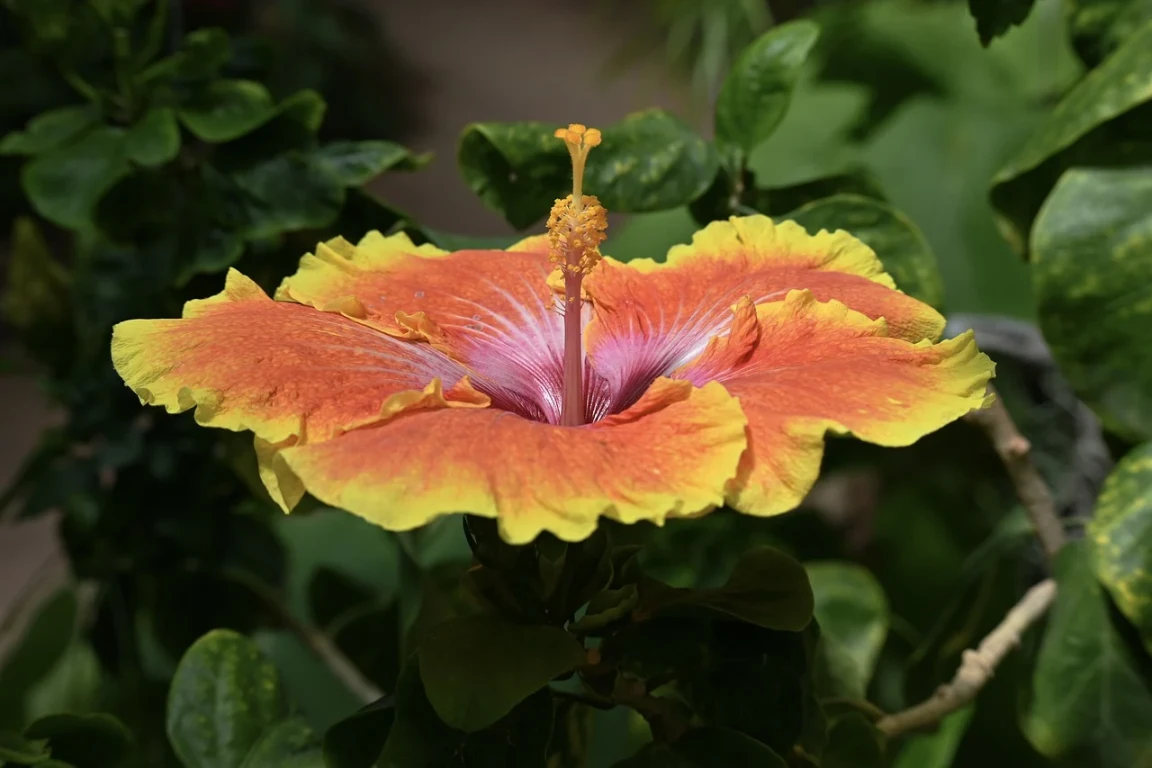
Different types of hibiscus
All hibiscus plants need sunlight, but not all plants have equal requirements. For the purpose of this article, we’re going to be grouping the hibiscus genus a little differently. In the past, we’ve dealt primarily with the hardy and tropical types of hibiscus. However, hardy usually refers more to the severity of colder temperatures the plant can handle and less to do with heat.
Additionally, there are more species of hibiscus than would fit neatly under those two limiting umbrellas. We’ve also dealt with the concept of perennials and annuals. However, this, too, does not meet the requirements for the knowledge we are discussing today.
Therefore, we are grouping the hibiscus genus into a more useful subset of species. We’re basing our groupings on the Köppen climate classification system – you know how much I love classification systems. This classification system, developed by German-Russian climatologist Wladimir Köppen, proposes 30 different climates worldwide.
However, a good many of these are far too cold for plants to thrive, so we can leave a few of them out. We’ll also be working with only the main climates and not the sub-climates, as including the latter would turn this into a novel or the start of a thesis. While a thesis likely will burst forth from this mind at some point, today is not the day.
Here are the climates we’ll be focussing on:
- Tropical – Encompassing Equatorial Africa, Southeast Asia, and Northern South America
- Arid – Encompassing Northern and Southern Africa, Australia, and Southern North America
- Mediterranean – Encompassing most of Europe surrounding the Meditteranean sea
This is by no means every climate that matters, but these are the climates where hibiscus is most commonly found natively. From this point forward, we will discuss these climates and the hibiscus species they produce briefly before heading into the light requirements for hibiscus plants in each climate. We’ll list two hibiscus species for each climate.
Tropical hibiscus species
As highlighted above, these are the species that thrive natively in tropical environments. You’d think that this section should contain that one hibiscus flower that everyone typically associates with island life. However, hibiscus Rosa-Sinensis is actually a more Mediterranean species. Here, you’ll find one species you may not have heard about and one with which you’ll be intimately familiar if you have ever dabbled with hibiscus in recipes.
Both species mentioned below require at least 6 hours of direct sunlight. We wouldn’t recommend planting either of these in the shade of a tree, even though both plants are fairly small compared to the behemoths that other species of hibiscus can become. The ideal place to put these babies is in direct sunlight. Wherever light and plants are concerned, another factor always comes into play – temperature.
Both of these species are accustomed to tropical temperatures, which range from about 77 to 82 degrees Fahrenheit (25 to 28 Celsius). This temperature range is fairly consistent all year round as the tropics rarely experience true winters or scorching summers. This, coupled with the fact that the tropical regions of the globe also experience a rather significant amount of rain throughout the year means that these species of hibiscus have grown accustomed to more humid weather than other species.
If you want your hibiscus to thrive, it’s best to try and replicate its native conditions as much as possible. The way you’d achieve this with the tropical species is to plant them where they can bask in the fullness of the sun for at least 6 hours. You also want to ensure that they don’t get too dry. While no hibiscus likes wet feet, these species do better in slightly more humid conditions. Thus, you should water your plant more frequently with less water.
So, you needn’t hit these species with that deep-watering tactic that we recommend for the hibiscus genus as a whole. The quickest expression for how to take care of tropical plants in terms of sunlight is that tropical plants require warm temperatures all year long and relatively moist, humid air. These babies like it hot and wet. But not too wet. And no wet feet.
Flower of an Hour
Hibiscus trionium
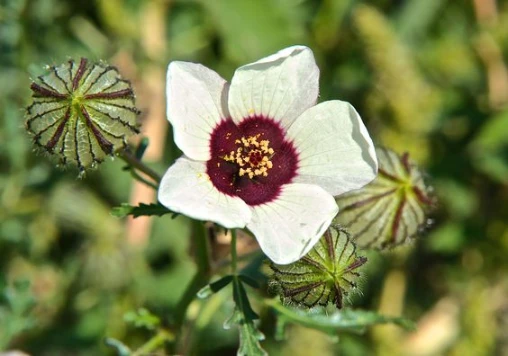
The Flower of an Hour is a smaller hibiscus species than most readers would be familiar with. Be that as it may, this is still one of the most eye-catching varieties. The stark white flower that seems to encircle a dominant deep red eye would be enough of a visual impact. But this little beauty caps it all off with what looks like a light dusting of pure gold in the form of anthers. Even the buds of this unassuming bloom are noteworthy. While the bud itself is a light, almost muted green, each has a concentration of crimson ridges that really stand out amongst nature’s crowd of flowers.
Roselle
Hibiscus sabdariffa
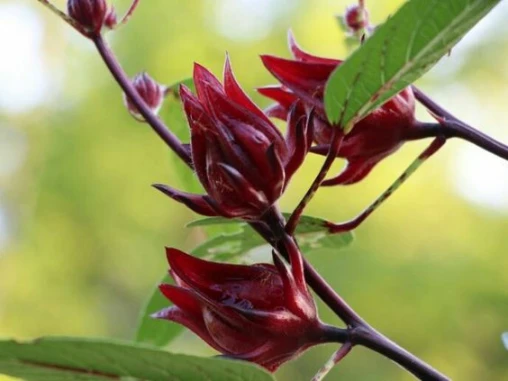
Roselle is quite possibly one of the more peculiar species of hibiscus. The image you usually see when you look up roselle, much like the one pictured above, is a fleshy crimson fruit-like structure with alien-like tendrils where the calyxes should be. This is the bud. As strange as the bud looks, the flower is almost stranger. When you look at the flower of hibiscus sabdariffa, you’ll see something similar to hibiscus trionium but slightly more delicate in appearance.
The actual petals of the flower are white and look almost as if they were sculpted from the finest lace. Toward the center of the flower, there’s a drastic shift from delicate white to a deep and domineering mattified crimson. It almost looks as if the center of the flower is a portal to another dimension. The core of this flower doesn’t seem to reflect much light; it’s quite a sight to behold.
Mediterranean hibiscus species
This is the section where you’ll find the classic flower that everyone simply refers to as the hibiscus. This is, in fact, the hibiscus Rosa-Sinensis to which we so often refer on this website. Another name for this beauty is the China Rose.
The other hibiscus species that we’ll cover in this section is the Rose of Sharon. Both of these, while advertised so widely as tropical plants, are actually primarily found in the Mediterranean regions of the earth. These regions, while similar in some ways to the tropical climates, experience slightly more distinct seasons and temperatures.
The Mediterranean climate is also called a dry summer temperate climate.
This tells you pretty much what you need to know about the differences between the Mediterranean and tropical climates. These climates average around 81 degrees Fahrenheit during the usual summer’s day (27 Celsius). However, the temperature can rise as high as 86- 100 degrees Fahrenheit during the hottest months of the year (30 -38 Celsius).
A quick way to express how to care for Mediterranean plants is that they require full sun and moderate warmth but prefer a slightly less moist, humid air environment.
China Rose
Hibiscus rosa-Sinensis
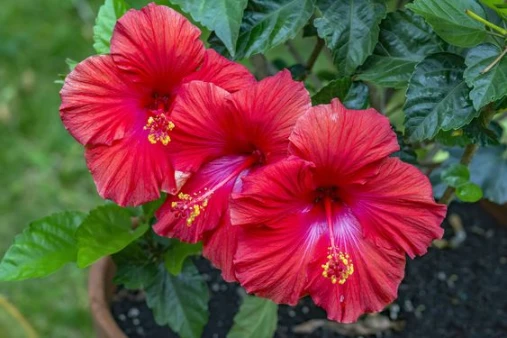
Hibiscus Rosa-sinensis, or the Rose of China, is what most people see in their heads when they hear the word hibiscus. Somehow, over many generations, this one species of hibiscus has come to be the poster child for the entire genus. It doesn’t take much to realize why this plant is so recognizable though; it’s quite literally everywhere. This is the favorite hibiscus species of many a gardener and horticultural enthusiast.
While it may be called the Rose of China, a name that it shares with other species of other genera of flowering plants, this hibiscus actually has very little to do with China. This is primarily a Mediterranean flowering shrub, so you’ll typically find it scattered throughout the Mediterranean regions of the world. However, many continents have Mediterranean regions, so this flower is found across the globe. Although, it’s pertinent to note that this is a particularly important flower to many of the Polynesian islands, numerous regions of Southeast Asia, and even some coastal communities in the Mediterranean basin.
This flower is incredibly easy to identify, due to its abundant presence in popular culture as the symbol of the Polynesian Islands. However, if you’re not sure what you’re looking for, here it is:
Hibiscus Rosa-sinensis has five large petals that sort of look like someone has scrunched them up and then tried to make them flat again.
They come in a variety of colors and cultivars, but the most common color is red. They typically have a darker eye in the center of the plant where the petals meet the reproductive structure of the flower and from this central structure you’ll see a number of anthers extend.
Rose of Sharon
Hibiscus Syriacus
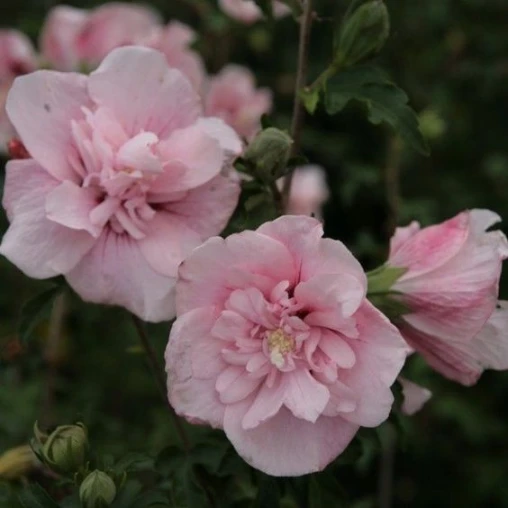
The Rose of Sharon is one of the most elegant-looking varieties of hibiscus, joining the Confederate Rose, which sits comfortably at the top of that list – in my opinion. The pure ethereal beauty of this flower comes from the presence of multiple corollas. This is what gives the Rose of Sharon its rose-like structure. Because of the complex structure that these stunning flowers possess, we in the horticultural world call these ‘showy flowers.’
Hibiscus syriacus loves to put on a magnificent show during each year’s blooming seasons. However, you need not let their brilliance intimidate you. These beauties would do just as well grown as border shrubs, low-lying shrubbery, or hedges. Even though they make a bold statement, not all hibiscus syriacus shrubs need to be grown as tall elegant statement pieces.
As you have likely come to expect of hibiscus plants, or indeed any plant native to the Mediterranean basin, Rose of Sharon requires full sunlight to bloom and thrive. However, if sufficient warmth still permeates the shady bits of your garden, you’d be perfectly justified exposing it to a little shade.
Where I live, for instance, even plants that require the fullest of sun spend quite a good deal of time in the shade. Spending too much time in our kind of direct sunlight will scorch plants beyond repair, and the shade is actually still quite warm here. I make it sound like I live in a volcano.
Arid hibiscus species
An arid climate is much drier than the climates we mentioned above. In most cases, it’s also a great deal hotter and doesn’t experience seasons the way other climates do. Instead, you should picture a land of near-eternal scorching summers. These places, as you’ll see when we mention where they’re found, are particularly close to the world’s most extreme deserts.
Arid landscapes are primarily found in Southern and Northern Africa, Australia, and the Southernmost reaches of North America. Picture the Sahara Desert, the entirety of Australia (just about) and regions of the North America such as Mexico. Even though there’s likely a tumbleweed rolling across a desert landscape in your mind right now, other plants do actually grow in these regions. Well, other than tumbleweeds and cacti.
In fact, you’ll find numerous hibiscus species in the arid climates of the world. Hibiscus aethiopicus, for instance, is a tiny beauty found in southern Africa.
Both of the species we’ll discuss below love full sunlight, and have adapted to growing and thriving in the hottest and driest conditions. Where many species of hibiscus would wilt and die within a few hours, these species reign supreme. Although, not really in the literal sense, because both of these species are considered low-lying shrubs.
Rock hibiscus
Hibiscus denudatus
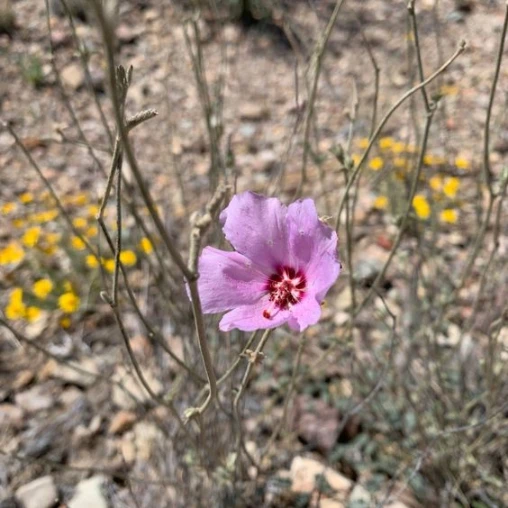
Hibiscus denudatus, or Rock hibiscus, is a native dweller of the Southernmost reaches of North America and, at first glance, doesn’t really look like hibiscus at all. Yes, it has five petals, but many flowers have five petals.
Fun fact: Scientists love to make up terms that describe the features of plants and flowers. For instance, someone studying the species wouldn’t necessarily say, ‘Hibiscus flowers have five petals.’ Instead, they’d say something along the lines of ‘Hibiscus is an example of a pentamerous bloom.’ Pentamerous, here, means having five petals. There is also a word for when a plant has five pointed leaves that look somewhat like a human hand. These leaves are known as having palmate venation. Palmate refers to the leaves looking like hands, and venation simply refers to the five main veins within the leaves joining together at the base of the leaf.
Rock hibiscus, also known as Paleface hibiscus, doesn’t actually look like a living plant most of the time, unless you count the pale pink flowers that it produces. However, for much of the year, these flowers seem only to be supported by a mass of dead twigs and sticks. This is just what this specific hibiscus looks like, and, if you explore the genus more fully, you’ll likely come across numerous hibiscus species that look a little stranger than most.
Even though, for the most part, this plant looks a little dead and parched, it’s perfectly suited to its environment. Moreover, when there’s a little moisture in the air, these babies produce soft green foliage that almost looks like its covered in little white hairs.
These don’t usually stay on for long though. See, the flowers are the reproductive organs of this plant, so it basically loses all its leaves when the temperatures get a little too extreme or dueing periods of intense drought. This way, there’s more nutrients to go toward keeping the flowers blooming and thus give the plant a fighting chance at reproduction.
Hibiscus aethiopicus
Hibiscus aethiopicus

Hibiscus aethiopicus is one of the many species of the genus that are known as dwarf hibiscus. This is because of their size. Particularly in the case of this specific species, it looks like a larger species of hibiscus has simply been shrunk down. If you subscribe to the theory of evolution, there’s no reason to doubt that once upon a time, millions of years ago, these plants may have been larger than life like their Polynesian cousins. However, as landscapes change, so too do the plants that depend upon them. In this case, it is thought that hibiscus aethiopicus shrank over time to make better use of the decrease in nutrients.
The other reason it could have gotten smaller was to escape the mouths of the herbivores that roamed the earth at any given time. We’ll likely explore the concept of plant evolution more fully in the future, at least, I’d like to. But, for now, all that’s really important is that this is a very small plant with very small flowers.
These minute blooms thrive in the undergrowth of the Southern African plains and Savannas. Basically, if you simply walk through the long grasses of the Savannas, you may miss them entirely. To find these beauties, you may have to move the long grasses gently to the side to expose what grows beneath. The African Savannas are basically best described as layers upon layers of ecosystems, and hibiscus aethiopicus exists in one of the lower ecosystems.
This is actually interesting because while hibiscus aethiopicus and hibiscus denudatus thrive in the same climate, they don’t do so under the same conditions. Hibiscus denudatus grows like a shrub, meaning that it is too tall to hide under other shrubs or plants. However, hibiscus aethiopicus uses other plants for cover – the tall grasses of the Savanna, for example. These tall grasses protect the hibiscus from harsh sunlight and heat, and in turn, the hibiscus thrives and pumps nutrients into the soil.
Not all hibiscus light requirements are equal
Sure, I’d happily make the argument that all species of hibiscus are equally beautiful, albeit in their own signature way. But, not all hibiscus species are equal in terms of the kind of light they require. THe most important thing to remember is that all these climates are different.
If you want to grow an arid species, you’ll need to ensure that your garden is hot and dry enough for them to thrive in. If you want to try your hand at primarily Mediterranean species, you’ll need to make sure that you keep them in drier air conditions wth slightly less water than if you were to grow a tropical species. Additionally, tropical species need more humidity than the other main types of hibiscus plants.
Essentially, when dealing with light requirements, you have to keep these other factors in mind too. Simply putting your tropical plant in the sun for with hours a day won’t make it thrive. It could, in fact, kill it. You need to ensure that you’re not only giving it adequate sunlight, but rather, adequate sunlight within the right environment.
As we always say, the best way to ensure the success of your hibiscus plant is to try and replicate it’s native environment as closely as possible. Do this, and your hibiscus should thrive and produce beautiful blooms.








